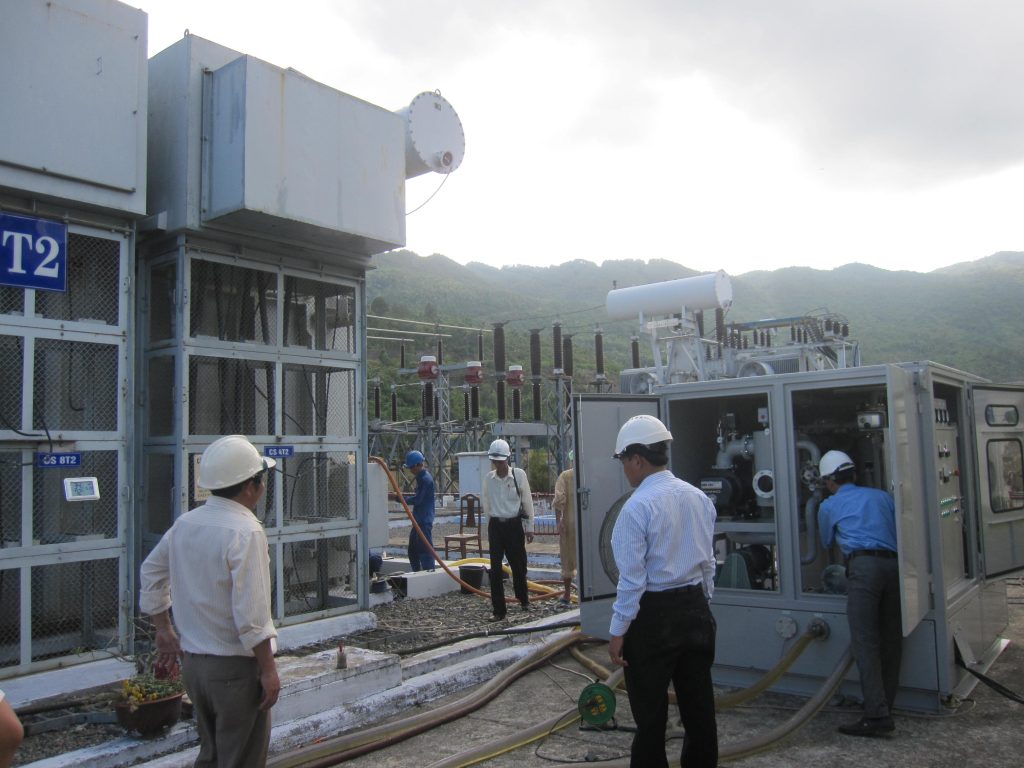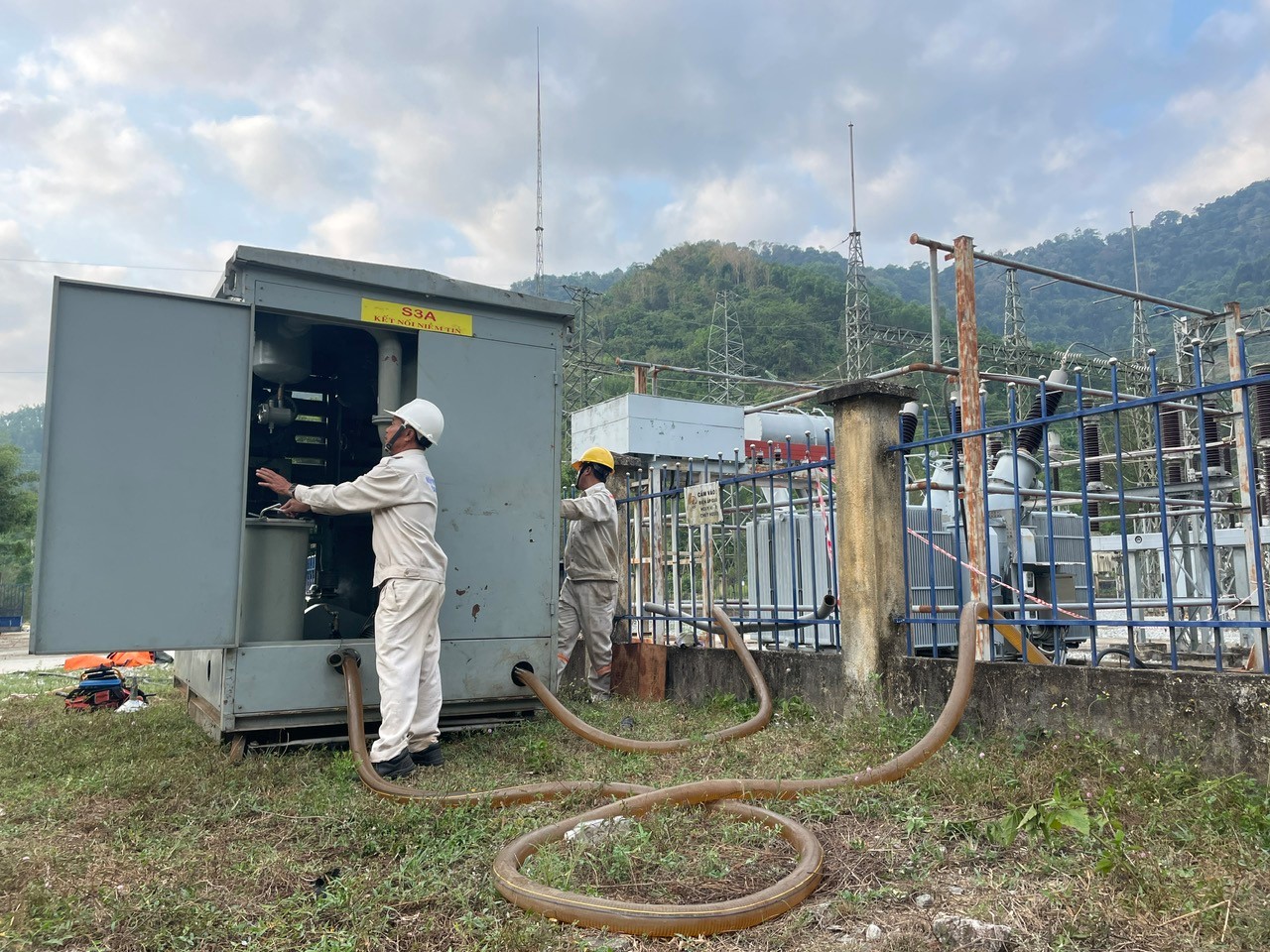News
Transformer Oil Filtering and Pumping Services at Site for Optimizing Efficiency and Durability
Table of contents:
The on-site transformer oil filtering and pumping service uses specialized equipment to process and clean the oil, removing impurities, moisture, gases, and harmful substances, thereby restoring and boosting insulation performance, reducing corrosion, and extending the transformer’s lifespan.
Process of filtering and pumping transformer oil
The process includes filtering the oil with specialized equipment, combining vacuum and heating. New or used transformer oil is treated to remove impurities, moisture, and dissolved gases like CO, CO2, O2, H2. This process increases the oil’s dielectric voltage from 30kV to 60-80kV, improving insulation performance and preventing incidents. Steps include draining old oil, cleaning the tank and piping, heating, primary filtering to remove large particles, vacuum treatment to separate water and gas, and finally pumping filtered oil back to the transformer or storage tank.
This oil filtering process aims to protect and maintain the optimal performance of transformers. During use, transformer oil easily becomes contaminated with impurities, moisture, and dissolved gases, negatively affecting insulation performance and lifespan. Transformer oil filtering not only removes these impurities but also enhances the dielectric voltage of the oil, increasing its value up to 60-80 kV.
The basic steps of this process include:
- System preparation and cleaning: Before filtering, all oil tanks and pipelines need thorough cleaning using specialized solutions instead of transformer oil to prevent further contamination.
- Draining old oil and inspection: Old transformer oil is drained from the system. Inspecting the oil quality at the tank bottom helps detect and eliminate large impurities.
- Heating oil: Heating transformer oil boosts filtering efficiency, allowing quicker moisture separation using infrared rays or special heaters.
- Primary filtering: Oil is initially filtered through a unit that removes impurities larger than 5 micrometers.
- Vacuum separation and dehydration: Using oil vacuum filtering equipment transforms oil to mist form, then removes moisture under low pressure conditions.
- Fine filtering: Once more, the oil is finely filtered to remove small dust particles and dissolved gases.
- Pumping clean oil: Finally, filtered and dehydrated oil is pumped back into storage tanks or transformers.
Equipment used in the process includes specialized oil filtering machines with vacuum, heating, and both coarse and fine filters. Oil conduits are usually polished galvanized pipes to ensure no pressure loss or oil contamination.
Some important technical notes:
- Even new oil requires filtering before use to remove impurities from transport.
- Transformer oil needs careful processing to maintain high insulation capabilities, especially in humid environments.
Proper transformer oil filtering not only enhances efficiency but also reduces the risk of damage and accidents for the system.

Importance of oil filtering service
The on-site transformer oil filtering and pumping service is crucial for maintaining and boosting transformer performance. Transformer oil often contains impurities, moisture, and dissolved gases that can reduce insulation efficiency and cause damage. Filtering oil helps restore the oil’s insulating properties, prevents rust formation, reduces risk from low dielectric voltage, extending device lifespan with optimal efficiency and transformer safety. This service is conducted directly at the site, saving transportation time and cost while ensuring operational safety.
Regular and proper oil filtering service is one of the critical factors in maintaining and extending the lifespan of electrical equipment. Transformer oil, serving as insulation and coolant, gradually accumulates impurities and moisture during operation. These impurities can include dirt particles, dissolved gases, and oxidation products such as acids and aldehydes, reducing insulation efficacy and risks of overheating.
To prevent damage, the transformer oil filtering service focuses on removing oil impurities and moisture, thereby improving insulation efficiency. The service not only protects the paper insulation layers and internal components of the transformer but also prevents corrosion and rust, maintaining durability and ensuring operational safety of the system.
Oil filtering methods, including online and offline filtering, are flexibly adjusted to suit varying operational conditions and maintenance purposes, achieving high efficiency and optimal cost savings. Particularly, water removal from oil is essential to ensure maximum insulation efficiency, as water is the main factor reducing oil’s insulating properties.
The transformer oil filtering service also offers significant benefits to large substations, especially where voltages of 110kV or more are present, enhancing system reliability and safety.

Equipment used in oil filtering
On-site oil filtering requires modern equipment such as oil filtering machines equipped with vacuum pumps and heaters. These devices effectively remove impurities, moisture, and harmful gases in the oil. By employing advanced technology, the oil filtering service optimizes insulation capabilities and significantly reduces equipment corrosion, contributing to energy savings and ensuring transformer safety. Furthermore, the equipment must be periodically checked and maintained to ensure stable and efficient operation.
Introduction to oil filtering equipment
Oil filtering is an essential process in industrial oil systems, aimed at protecting and maintaining the performance of operating devices. Advances in technology have introduced more efficient solutions to improve oil quality, thus extending the lifespan of devices.
Common types of oil filtering equipment
- Hydraulic oil filter machine: Uses oil pumps and filtering material layers such as paper, fabric, or fiberglass to trap impurities, effectively protecting hydraulic systems.
- Vacuum oil filter machine: Equipped with a heating filter and vacuum pump, the vacuum oil filter machine removes water and gases from oil by utilizing the saturation temperature difference between water and oil.
- Centrifugal oil filter machine: Applies centrifugal force to separate solid and liquid impurities, suitable for oils with varying contamination levels.
- Electrostatic oil filter machine: Uses an electrostatic field to separate and remove dispersed impurities in oil, suitable for specialized industries.
- Compressed air oil filter machine: Quickly removes impurities by pushing oil through a cloth filter using compressed air, suitable for large production lines.
Importance of oil filtering equipment
The use of oil filtering machines such as hydraulic, vacuum, and other devices provides not only technical benefits but also cost optimization in operations. This helps extend oil lifespan and protect systems, minimizing the need for frequent maintenance and replacements.
Effectiveness of filtering material
Filtering material components such as filter paper, specialized fabric, and fiberglass are selected based on purpose and type of oil filtering machine, aiming to enhance impurity removal efficiency, contributing to overall improved oil filtering quality.

On-site transformer oil filtering and pumping service not only enhances oil’s insulation features but also reduces equipment corrosion, boosts safety, and optimizes operational efficiency. By utilizing advanced oil filtering technology, maintenance costs are optimized while maintaining stable electricity system operations.
Contact QuangAnhcons for detailed advice on on-site transformer oil filtering and pumping services, via hotline: +84 9 1975 8191.
QuangAnhcons provides on-site transformer oil filtering and pumping services, processing and cleaning oil to remove harmful impurities, moisture, and gases, while enhancing insulation efficiency and extending device lifespan.

 Tiếng Việt
Tiếng Việt 简体中文
简体中文 Deutsch
Deutsch 日本語
日本語 한국어
한국어 ไทย
ไทย Русский
Русский Français
Français